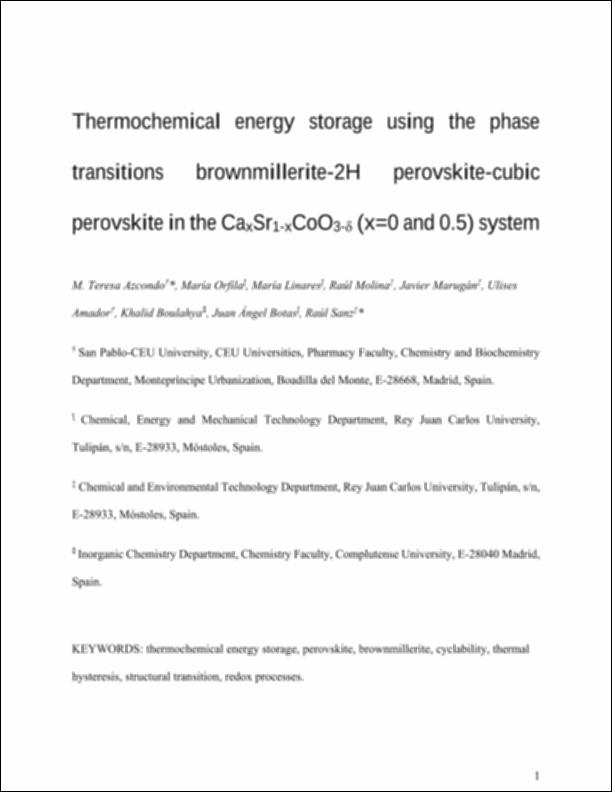Please use this identifier to cite or link to this item:
http://hdl.handle.net/10637/14774Thermochemical Energy Storage Using the Phase Transitions Brownmillerite -2H Perovskite - Cubic Perovskite in the CaxSr1–xCoO3−δ (x = 0 and 0.5) System
| Title: | Thermochemical Energy Storage Using the Phase Transitions Brownmillerite -2H Perovskite - Cubic Perovskite in the CaxSr1–xCoO3−δ (x = 0 and 0.5) System |
| Authors : | Azcondo Sánchez, María Teresa Orfila, María Linares, María Molina, Raúl Marugán, Javier Amador Elizondo, Ulises Julio Boulahya, Khalid Botas, Juan Ángel Sanz, Raúl |
| Keywords: | Thermochemical energy storage; Perovskite; Brownmillerite; Cyclability; Thermal hysteresis; Structural transition; Redox processes |
| Publisher: | American Chemical Society |
| Citation: | Víctor Zapata-Ramírez, Paula Rosendo-Santos, Ulises Amador, Clemens Ritter, Glenn C. Mather, Domingo Pérez-Coll, Optimisation of high-performance, cobalt-free SrFe1-xMoxO3-y cathodes for solid oxide fuel cells prepared by spray pyrolysis, Renewable Energy, 2022 185, 1167-1176. DOI: 10.1016/j.renene.2021.12.121 |
| Abstract: | The oxides Ca0.5Sr0.5CoO3-δ and SrCoO3-δ, which present perovskite or perovskite-related phases in different temperature domains, have been tested as materials for thermochemical energy storage. The first one, Ca0.5Sr0.5CoO3-δ, experiences a reversible phase transition upon consecutive cycles under air flow at a maximum operating temperature of 1196 K. Unfortunately, the heat stored in this process, associated to an oxygen loss/gain and a structural phase transition, is very small hindering its use for thermochemical heat storage. The as-prepared oxide SrCoO3-δ, which displays a brownmillerite structure like the Ca-containing compound, in the first heating step irreversibly segregates some Co3O4 at 823 K to yield a 2H hexagonal-perovskite. This phase reversibly transforms at 1073 K into a cubic-perovskite. These 2H⇄C transition occurs from the second to, at least, thirty cycles. The average absorbed and released heat are ~104.1±0.06 J/g and ~68.8±1.8 J/g, respectively, and therefore SrCoO3-δ presents a high exo/endo ratio. The exergy efficiency is, on average for the 30 cycles performed, as high as 63.9±1.2%. The mechanism of the phase 2H⇄C transition of SrCoO3-δ explains the good performance of this material for thermochemical energy storage. |
| URI: | http://hdl.handle.net/10637/14774 |
| Rights : | http://creativecommons.org/licenses/by-nc-nd/4.0/deed.es |
| ISSN: | 2574-0962 |
| Issue Date: | 9-Aug-2021 |
| Center : | Universidad San Pablo-CEU |
| Appears in Collections: | Facultad de Farmacia |
Items in DSpace are protected by copyright, with all rights reserved, unless otherwise indicated.


